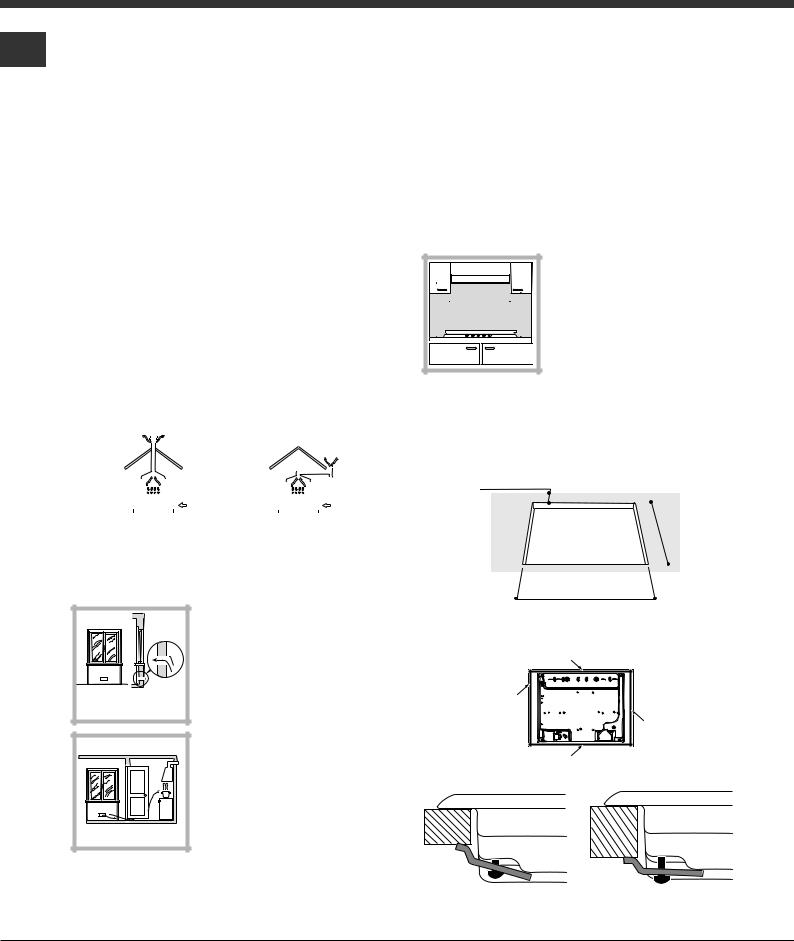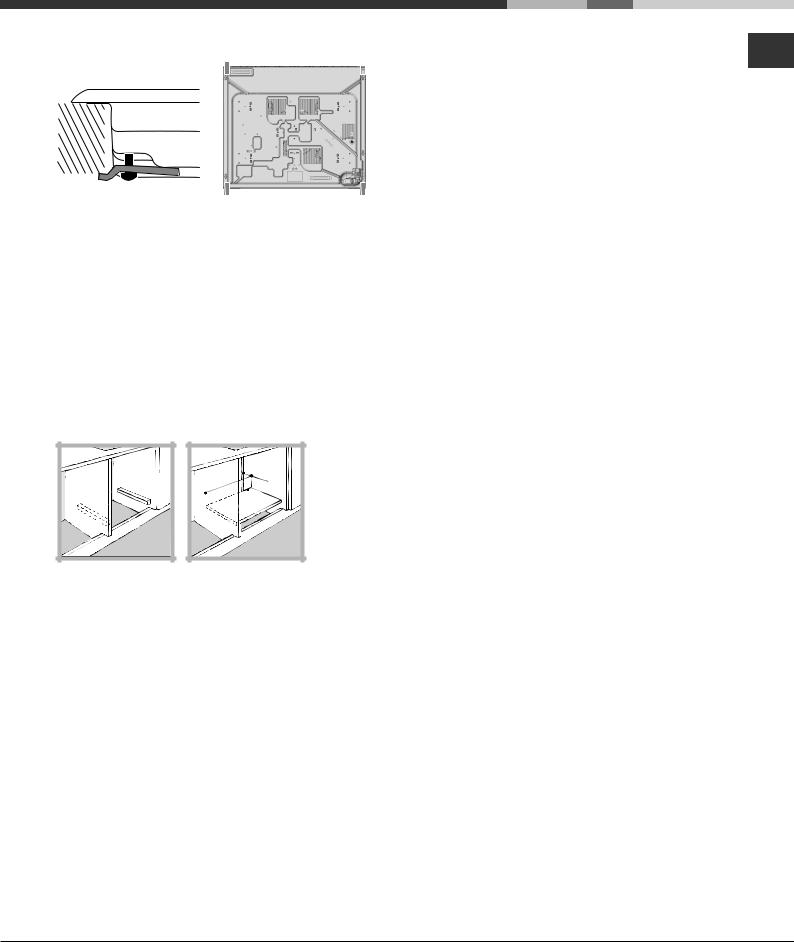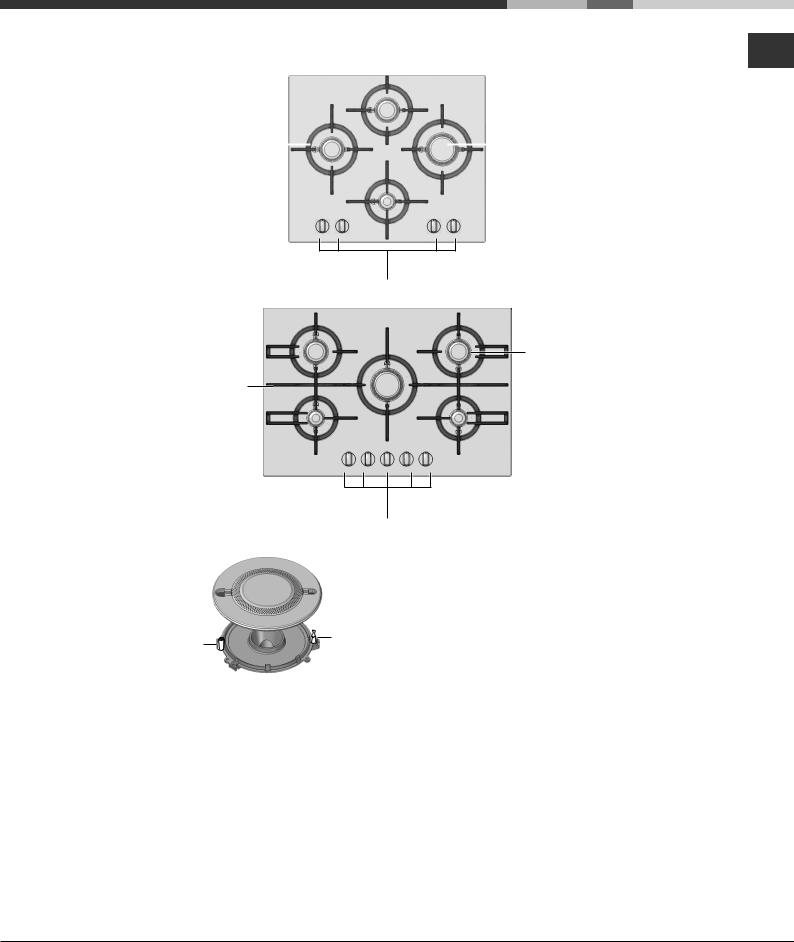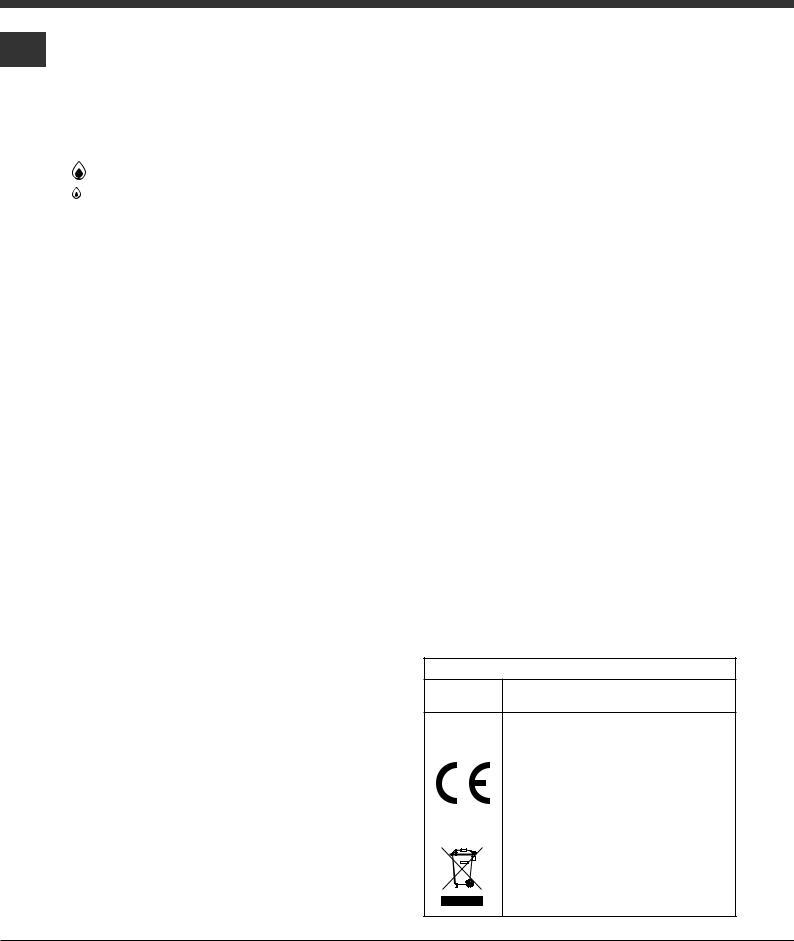Hotpoint-ariston 7HPK 755 D GH X User Manual [ru]

Operating Instructions
HOB
|
|
|
|
|
|
|
|
|
|
|
|
|
|
|
|
|
Contents |
|
|||
|
|
|
|
|
|
GB |
||||
|
|
|
|
|
|
|
|
|
|
|
|
|
|
|
|
|
Installation, 2-4 |
|
|||
|
GB |
|
RS |
|
KZ |
|
||||
|
|
|
Positioning |
|||||||
|
|
|
|
|
|
Electrical connection |
||||
|
|
|
|
|
|
|||||
English, 1 |
Русский, 10 |
|
Gas connection |
|||||||
|
|
|
|
|
|
Burner and nozzle specifications |
||||
Description of the appliance, 5
Overall view
Start-up and use, 6
Practical advice on using the burners
Data plate
7HPK 644 D GH X /HA 7HPKQ 644 D GH /HA 7HPK 755 D GH X/HA 7HPKQ 755 D GH /HA
Precautions and tips, 7
General safety Disposal
Maintenance and care, 8
Switching the appliance off Cleaning the appliance Gas tap maintenance
Troubleshooting, 9
1

Installation
! Before operating your new appliance please read this
GB instruction booklet carefully. It contains important information for safe use, installation and care of the appliance.
! Please keep these operating instructions for future reference. Pass them on to possible new owners of the appliance.
Positioning
!Keep packaging material out of the reach of children. It can become a choking or suffocation hazard (see Precautions and tips).
!The appliance must be installed by a qualified professional according to the instructions provided. Incorrect installation may cause harm to people and animals or may damage property.
!This unit may be installed and used only in permanently ventilated rooms in accordance with British Standard Codes Of Practice: B.S. 6172 / B.S. 5440, Par. 2 and B.S. 6891 Current Editions. The following requirements must be observed:
•The room must be equipped with an air extraction system that expels any combustion fumes. This may consist of a hood or an electric fan that automatically starts each time the appliance is switched on.
|
|
|
|
|
|
|
|
|
|
|
|
|
|
|
|
|
|
|
|
|
|
|
|
|
|
|
|
|
|
|
|
|
|
|
|
|
|
|
|
|
|
|
|
|
|
|
|
|
|
|
|
|
|
|
|
|
|
|
|
|
|
|
|
|
|
|
|
|
|
|
|
|
|
|
|
|
|
|
|
|
|
|
|
|
|
|
|
|
|
|
|
|
|
|
|
|
|
|
|
|
|
|
|
|
|
|
|
|
|
|
|
|
|
|
|
|
|
|
|
|
|
|
|
|
|
In a chimney stack or branched flue. |
Directly to |
|
|
|
|
|||||||||||||||
(exclusively for cooking appliances) |
the Outside |
|
|
|
|
|||||||||||||||
|
|
|
|
|
|
|
|
|
|
|
|
|
|
|
|
|
|
|
|
|
•The room must also allow proper air circulation, as air is needed for combustion to occur normally. The flow of air
must not be less than 2 m3/h per kW of installed power. The air circulation system may
take air directly from the outside
by means of a pipe with an inner
cross section of at least 100 cm2; the opening must not be vulnerable to any type of blockages.
Adjacent |
Room to be |
Room |
Vented |
Enlarging the ventilation slot |
|
between window and floor. |
|
The system can also provide the air needed for combustion indirectly, i.e. from adjacent rooms fitted with air circulation tubes as described above. However, these rooms must not be communal rooms, bedrooms or rooms that may present a fire hazard.
Fitting the appliance
Gas and mixed hobs are manufactured with type X degree protection against overheating. The following precautions must be taken when installing the hob:
•Kitchen cabinets adjacent to the appliance and taller than the top of the hob must be at least 600 mm from the edge of the hob.
•Hoods must be installed according to their relative installation instruction manuals and at a minimum distance of 650 mm from the hob.
•Place the wall cabinets adjacent to the hood at a minimum height of 420 mm from the hob (see figure).
|
600mm min. |
700mmmin. |
600mmmin. |
If the hob is installed beneath a wall cabinet, the latter must be situated at a minimum of 700 mm above the hob (see figure).
•The installation cavity should have the dimensions indicated in the figure. Fastening hooks are provided, allowing you to fasten the hob to tops that are between 20 and 40 mm thick. To ensure the hob is securely fastened to the top, we recommend you use all the
hooks provided.
55 mm
475 mm
555 mm
•Before fastening the cooktop in place, position the seal (supplied) along the perimeter of the countertop, as shown in the figure.
Hook fastening diagram
Hooking position |
Hooking position |
for top H=20 mm |
for top H=30 mm |
2

Front
|
|
Back |
|
|
|
|
|
|
|
|
|
Hooking position |
|
||
for top H=40 mm |
|
|
|
! Use the hooks contained in the “accessory pack”
•Where the hob is not installed over a built-in oven, a wooden panel must be installed as insulation. This must be placed at a minimum distance of 20 mm from the lower part of the hob.
Ventilation
To ensure adequate ventilation, the back panel of the cabinet must be removed. It is advisable to install the oven so that it rests on two strips of wood, or on a completely flat surface with an opening of at least 45 x 560 mm (see diagrams).
. |
45 |
mm |
. |
mm |
|
||
560 |
|
|
|
! The hob can only be installed above built-in ovens with a cooling ventilation system.
Electricalconnection
Hobs equipped with a three-pole power supply cable are designed to operate with alternating current at the voltage and frequency indicated on the data plate (this is located on the lower part of the appliance). The earth wire in the cable has a green and yellow cover. If the appliance is to be installed above a built-in electric oven, the electrical connection of the hob and the oven must be carried out separately, both for electrical safety purposes and to make extracting the oven easier.
Connecting the supply cable to the mains
Install a standardised plug corresponding to the load indicated on the data plate.
The appliance must be directly connected to the mains using an omnipolar circuit-breaker with a minimum contact opening of 3 mm installed between the appliance and the mains. The circuit-breaker must be suitable for the charge indicated
and must comply with current electrical regulations (the
earthing wire must not be interrupted by the circuit-breaker). GB The supply cable must not come into contact with surfaces
with temperatures higher than 50°C.
! The installer must ensure that the correct electrical connection has been made and that it is compliant with safety regulations.
Before connecting to the power supply, make sure that:
•The appliance is earthed and the plug is compliant with the law.
•The socket can withstand the maximum power of the appliance, which is indicated on the data plate.
•The voltage is in the range between the values indicated on the data plate.
•The socket is compatible with the plug of the appliance. If the socket is incompatible with the plug, ask an authorised technician to replace it. Do not use extension cords or multiple sockets.
!Once the appliance has been installed, the power supply cable and the electrical socket must be easily accessible.
!The cable must not be bent or compressed.
!The cable must be checked regularly and replaced by authorised technicians only (see Assistance).
!The manufacturer declines any liability should these safety measures not be observed.
Gas connection
The appliance should be connected to the main gas supply in compliance with current national regulations. Before carrying out the connection, make sure the cooker is compatible with the gas supply you wish to use.
! Check that the pressure of the gas supply is consistent with the values indicated in Table 1 (“Burner and nozzle specifications”). This will ensure the safe operation and longevity of your appliance while maintaining efficient energy consumption.
Connection with a rigid pipe (copper or steel)
! Connection to the gas system must be carried out in such a way as not to place any strain of any kind on the appliance.
There is an adjustable L-shaped pipe fitting on the appliance supply ramp and this is fitted with a seal in order to prevent leaks. The seal must always be replaced after rotating the pipe fitting (seal provided with appliance). The gas supply pipe fitting is a threaded 1/2 gas cylindrical male attachment.
3

Connecting a flexible jointless stainless steel pipe to a
GB |
threaded attachment |
|
|
|
The gas supply pipe fitting is a threaded 1/2 gas |
|
cylindrical male attachment. |
|
These pipes must be installed so that they are never |
|
longer than 2000 mm when fully extended. Once |
|
connection has been carried out, make sure that the |
|
flexible metal pipe does not touch any moving parts and |
|
is not compressed. |
|
! Only use pipes and seals that comply with current |
|
national regulations. |
Checking the tightness of the connection
!When the installation process is complete, check the pipe fittings for leaks using a soapy solution. Never use a flame.
!Should the gas pressure used be different (or vary slightly) from the recommended pressure, a suitable pressure regulator must be fitted to the inlet pipe (in order to comply with current national regulations).
Burner and nozzle specifications
Table 1 |
|
|
|
|
Natural Gas |
Adjusting the burner’s |
||
|
|
|
|
|
(G20 / 20 mbar) |
primary air |
||
|
|
|
|
|
|
|
|
|
Burner |
Diameter |
Thermal Power |
Nozzle |
|
Flow* |
|
||
|
(mm) |
kW (p.c.s.*) |
1/100 |
|
l/h |
|
||
|
|
Nomin. |
|
Reduc. |
(mm) |
|
(G20) |
(mm) |
|
|
|
|
|||||
|
|
|
|
|
|
|
|
|
Fast (R) |
157 |
3.00 |
|
1.00 |
125 |
|
286 |
4.7 |
|
|
|
|
|
|
|
|
|
Semi Fast (S) |
132 |
1.90 |
|
0.80 |
100 |
|
157 |
2.6 |
|
|
|
|
|
|
|
|
|
Auxiliary (A) |
110 |
1.00 |
|
0.50 |
72 |
|
95 |
2 |
|
|
|
|
|
|
|
|
|
Supply pressures |
Nominal (mbar) |
|
20 |
|
||||
Minimum (mbar) |
|
17 |
|
|||||
|
Maximum (mbar) |
|
25 |
|
||||
|
|
|
|
|
|
|
|
|
*At 15°C and 1013 mbar-dry gas Natural P.C.S. = 37.78 MJ/m³
|
S |
S |
S |
S |
R |
|
R |
|
A |
A |
A |
7HPK 644 D GH X /HA 7HPKQ 644 D GH /HA
7HPK 755 D GH X/HA 7HPKQ 755 D GH /HA
4

Description of the appliance
Overall view
GB
Support Grid for |
|
|
|
GAS BURNERS |
|
|
|
||
COOKWARE |
|
|
|
|
Control Knobs for
GAS BURNERS
GAS BURNERS
Support Grid for
COOKWARE
Control Knobs for
GAS BURNERS
Ignition for
SAFETY
GAS BURNERS
DEVICES
! The largest slot should be inserted into the ignition.
•GAS BURNERS differ in size and power. Use the diameter of the cookware to choose the most appropriate burner to cook with.
•Control Knobs for GAS BURNERS adjust the size of the flame.
•GAS BURNER ignition enables a specific burner to be lit automatically.
•SAFETY DEVICE stops the gas flow if the flame is accidentally extinguished.
5

Start-up and use
! The position of the corresponding gas burner or
GB |
electric hotplate* is shown on every knob. |
|
|
||
|
Gas burners |
|
|
Each burner can be adjusted to one of the following |
|
|
settings using the corresponding control knob: |
|
|
• |
Off |
|
|
Maximum |
|
|
Minimum |
To turn on one of the burners, place a lighted match or lighter near the burner, press the knob all the way in and turn it anti-clockwise to the "High" setting.
The knob must be pressed in for about 6 seconds until the device that keeps the flame lit warms up. Some models are equipped with an ignition button incorporated into the control knob. If this is the case, the ignitor is present. To light a burner, simply press the corresponding knob all the way in and then turn it anti-clockwise to the "High" setting, keeping it pressed in until the burner lights.
! If a flame is accidentally extinguished, turn off the control knob and wait for at least 1 minute before trying to relight it.
To switch off the burner, turn the knob in a clockwise direction until it stops (when reaches the “•” position).
Practical advice on using the burners
To ensure the burners operate efficiently:
•Use appropriate cookware for each burner (see table) so that the flames do not extend beyond the bottom of the cookware.
•Always use cookware with a flat base and a cover.
•When the contents of the pan reach boiling point, turn the knob to minimum.
Burner |
Ø Cookware Diameter (cm) |
|
|
Fast (R) |
24 - 26 |
|
|
Semi Fast (S) |
16 - 20 |
|
|
Auxiliary (A) |
10 - 14 |
|
|
To identify the type of burner, refer to the designs in the section entitled, "Burner and Nozzle Specifications".
! Make sure the pans do not overlap the edges of the hob while it is being used.
DATA PLATE
Electrical
connections see data plate
This appliance conforms to the following
European Economic Community directives:
-2006/95/EEC dated 12/12/06 (Low Voltage) and subsequent amendments
-2004/108/EEC dated 15/12/04 (Electromagnetic Compatibility) and subsequent amendments
-93/68/EEC dated 22/07/93 and subsequent amendments.
- 2009/142/EEC dated 30/11/09 (Gas) and subsequent amendments.
- 2002/96/EC and subsequent amendments.
6

Precautions and tips
! This appliance has been designed and manufactured in compliance with international safety standards. The following warnings are provided for safety reasons and must be read carefully.
General safety
•This is a class 3 built-in appliance.
•Gas appliances require regular air exchange to maintain efficient operation. When installing the hob, follow the instructions provided in the paragraph on “Positioning” the appliance.
•These instructions are only valid for the countries whose symbols appear in the manual and on the serial number plate.
•The appliance was designed for domestic use inside the home and is not intended for commercial or industrial use.
•The appliance must not be installed outdoors, even in covered areas. It is extremely dangerous to leave the appliance exposed to rain and storms.
•Do not touch the appliance with bare feet or with wet or damp hands and feet.
•The appliance must be used by adults only for the preparation of food, in accordance with the instructions outlined in this booklet. Any other use of the appliance (e.g. for heating the room) constitutes improper use and is dangerous.
The manufacturer may not be held liable for any damage resulting from improper, incorrect and unreasonable use of the appliance.
•Ensure that the power supply cables of other electrical appliances do not come into contact with the hot parts of the oven.
•The openings used for ventilation and dispersion of heat must never be covered.
•Always make sure the knobs are in the “ ”/“ ” position when the appliance is not in use.
•When unplugging the appliance always pull the plug from the mains socket, do not pull on the cable.
•Never carry out any cleaning or maintenance work without having detached the plug from the mains.
• In case of malfunction, under no circumstances
should you attempt to repair the appliance |
GB |
|
|
yourself. Repairs carried out by inexperienced |
|
persons may cause injury or further |
|
malfunctioning of the appliance. Contact a Service |
|
Centre (see Assistance). |
|
•Always make sure that pan handles are turned towards the centre of the hob in order to avoid accidental burns.
•Do not use unstable or deformed pans.
•The appliance should not be operated by people (including children) with reduced physical, sensory or mental capacities, by inexperienced individuals or by anyone who is not familiar with the product. These individuals should, at the very least, be supervised by someone who assumes responsibility for their safety or receive preliminary instructions relating to the operation of the appliance.
•Do not let children play with the appliance.
•The appliance is not intended to be operated by means of an external timer or separate remote-control system.
Disposal
•When disposing of packaging material: observe local legislation so that the packaging may be reused.
•The European Directive 2002/96/EC on Waste Electrical and Electronic Equipment (WEEE), requires that old household electrical appliances must not be disposed of in the normal unsorted municipal waste stream. Old appliances must be collected separately in order to optimise the recovery and recycling of the materials they contain and reduce the impact on human health and the environment. The crossed out “wheeled bin” symbol on the product reminds you of your obligation, that when you dispose of the appliance it must be separately collected. Consumers may take their old appliance to public waste collection areas, other communal collection areas, or if national legislation allows return it to a retailer when purchasing a similar new product. All major household appliance manufacturers are active in the creation of systems to manage the collection and disposal of old appliances.
7

Maintenance and care
Switching the appliance off
GB
Disconnect your appliance from the electricity supply before carrying out any work on it.
Cleaning the appliance
!Do not use abrasive or corrosive detergents such as stain removers, anti-rust products, powder detergents or sponges with abrasive surfaces: these may scratch the surface beyond repair.
!Never use steam cleaners or pressure cleaners on the appliance.
•It is usually enough to wash the hob with a damp sponge and dry it with absorbent kitchen roll.
•The removable parts of the burners should be washed frequently with warm water and soap and any burnt-on substances removed.
•For hobs which ligth automatically, the terminal part of the electronic instant lighting devices should be cleaned frequently and the gas outlet holes should be checked for blockages.
•Before using the ceramic glass module, the surface must be cleaned, using a damp cloth to remove dust or food residues. The ceramic glass surface should be cleaned regularly with a soultion of warm water and a non-abrasive detergent. Periodically, special products will need to be used to clean the surface. First, remove all
food buildup or grease with a cleaning scraper,
e.g. 

 (not supplied.
(not supplied.
Clean the cooking surface when it is still warm with a suitable cleaning product (such as the one in the Solutions product line available from any After-Sales Service Centre) and paper towels. Then rub with a damp cloth and dry. Aluminum foil, plastic items, objects made of synthetic
material, sugar or foods with a high sugar content that have melted onto the surface must be removed  immediatley with a
immediatley with a  scraper while the
scraper while the  cooking surface is
cooking surface is
still hot. Special
cleaning products for ceramic glass surfaces form a
transparent protective layer which
fights diry buildup. This also protects the surface from
damage caused by food with a high
sugar content. Do
not use abrasive sponges or cleaning products under any
circumstances. This holds true for
chemically aggressive cleaners, like oven sprays and stain removers.
•Stainless steel can be marked by hard water that has been left on the surface for a long time, or by aggressive detergents containing phosphorus.
After cleaning, rinse and dry any remaining drops of water.
! Do not use stainless steel flame spreaders, bread toasters or meat grills over gas flames.
Gas tap maintenance
Over time, the taps may become jammed or difficult to turn. If this happens, the tap must be replaced.
! This procedure must be performed by a qualified technician authorised by the manufacturer.
8

Troubleshooting
It may happen that the appliance does not function properly or at all. Before calling the service centre for
assistance, check if anything can be done. First, check to see that there are no interruptions in the gas and GB electrical supplies, and, in particular, that the gas valves for the mains are open.
Problem
The burner does not light or the flame is not even around the burner.
The flame dies in models with a safety device.
The burner does not remain lit when set to minimum.
The cookware is unstable.
Possible causes/Solution
•The gas holes on the burner are clogged.
•All the movable parts that make up the burner are mounted correctly.
•There are draughts near the appliance.
•You pressed the knob all the way in.
•You keep the knob pressed in long enough to activate the safety device.
•The gas holes are not blocked in the area corresponding to the safety device.
•The gas holes are not blocked.
•There are no draughts near the appliance.
•The minimum setting has been adjusted properly.
•The bottom of the cookware is perfectly flat.
•The cookware is positioned correctly at the centre of the burner.
•The pan support grids have been positioned correctly.
If, despite all these checks, the hob does not function properly and the problem persists, call the nearest Customer Service Centre. Please have the following information handy:
•The appliance model (Mod.).
•The serial number (S/N).
This information can be found on the data plate located on the appliance and/or on the packaging.
! Never use unauthorised technicians and never accept replacement parts which are not original.
9

Руководство по эксплуатации
RS
GB |
|
RS |
|
KZ |
|
|
|
|
|
English, 1 |
Русский, 10 |
|
||
7HPK 644 D GH X /HA 7HPKQ 644 D GH /HA 7HPK 755 D GH X/HA 7HPKQ 755 D GH /HA
ВАРОЧНАЯ ПАНЕЛЬ
Содержание
Монтаж, 11-14
Расположение Электрическое подключение Подсоединение к газопроводу
Характеристики конфорок и форсунок
Описание изделия, 15
Общии вид
Включение и эксплуатация, 16
Практические советы по эксплуатации конфорок
Предосторожности и рекомендации, 17
Общие требования к безопасности Утилизация
Техническое обслуживание и уход, 18
Отключение электропитания Чистка изделия
Уход за рукоятками газовои варочнои панели
Неисправности и методы их устранения, 19
Паспортная табличка, 20
10
